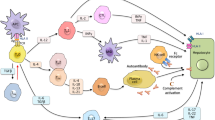Summary:
We describe two brothers who suffered from hyper-IgM syndrome (HIGM1) with similar clinical features: recurrent infections, especially cryptosporidium gastroenteritis with cholangitis. Their activated T cells did not express CD40L. Nucleotide sequencing revealed a mutation in both boys with respect to intron 4 and exon 5 boundaries of the CD40L gene in Xq26. They underwent successful bone marrow transplantation (BMT) from HLA-geno-identical siblings. The Cryptosporidium infection and cholangitis resolved thereafter. At 6 months after BMT, expression of CD40L on activated T lymphocytes was normal. After 1 year, both boys are well, and immune reconstitution has improved. Based on these two successful experiences, BMT with a genoidentical sibling seems a reasonable therapeutic approach for HIGM1, if Cryptosporidium infection occurs.
This is a preview of subscription content, access via your institution
Access options
Subscribe to this journal
Receive 12 print issues and online access
$259.00 per year
only $21.58 per issue
Buy this article
- Purchase on Springer Link
- Instant access to full article PDF
Prices may be subject to local taxes which are calculated during checkout


Similar content being viewed by others
References
Puck JM . A disease gene for autosomal hyper-IgM syndrome: more genes associated with more immunodeficiencies. Clin Immunol 2000; 97: 191–192.
Fuleihan RL . Hyper IgM syndrome: the other side of the coin. Curr Opin Pediatr 2001; 13: 528–532.
Fries KM, Sempowski GD, Gaspari AA et al. CD40 expression by human fibroblasts. Clin Immunol Immunopathol 1995; 77: 42–51.
Hayward AR, Levy J, Facchetti F et al. Cholangiopathy and tumors of the pancreas, liver, and biliary tree in boys with X-linked immunodeficiency with hyper-IgM. J Immunol 1997; 158: 977–983.
Hayward AR, Cosyns M, Jones M, Ponnuraj EM . Marrow-derived CD40-positive cells are required for mice to clear Cryptosporidium parvum infection. Infect Immun 2000; 69: 1630–1634.
Thomas C, De Saint Basile G, Le Deist F et al. Brief report: correction of X-linked hyper-IgM syndrome by allogeneic bone marrow transplantation. N Engl J Med 1995; 333: 126–129.
Bordigoni P, Auburtin B, Carret AS et al. Bone marrow transplantation as treatment for X-linked immunodeficiency with hyper-IgM. Bone Marrow Transplant 1998; 22: 1111–1114.
Amrolia P, Gaspar H, Hassan A et al. Nonmyeloablative stem cell transplantation for congenital immunodeficiencies. Blood 2000; 96: 1239–1246.
Khawaja K, Gennery AR, Flood TJ et al. Bone marrow transplantation for CD40 ligand deficiency: a single centre experience. Arch Dis Child 2001; 84: 508–511.
Wu Z, Nagano I, Matsuo A, Uga S et al . Specific PCR primers for Cryptosporidium parvum with extra high sensitivity. Mol Cell Probes 2000; 14: 33–39.
Hadzic N, Pagliuca A, Rela M et al. Correction of the hyper-IgM syndrome after liver and bone marrow transplantation. N Engl J Med 2000; 342: 320–324.
Martinez Ibanez V, Espanol T, Matamoros N et al. Relapse of sclerosing cholangitis after liver transplant in patients with hyper-IgM syndrome. Transplant Proc 1997; 29: 432–433.
Levy J, Espanol-Boren T, Thomas C et al . Clinical spectrum of X-linked hyper-IgM syndrome. J Pediatr 1997; 131: 47–54.
Vestereng VH, Kovacs JA . Recombinant CD40 ligand administration does not decrease intensity of Pneumocystis carinii infection in SCID mice. J Eucaryot Microbiol 2001: (Suppl.): 153S–154S.
Acknowledgements
We thank Mrs D Binot Saintot and S Lapuyade for their excellent technical assistance.
Author information
Authors and Affiliations
Corresponding author
Additional information
The first two authors contributed equally to this work
Rights and permissions
About this article
Cite this article
Dimicoli, S., Bensoussan, D., Latger-Cannard, V. et al. Complete recovery from Cryptosporidium parvum infection with gastroenteritis and sclerosing cholangitis after successful bone marrow transplantation in two brothers with X-linked hyper-IgM syndrome. Bone Marrow Transplant 32, 733–737 (2003). https://doi.org/10.1038/sj.bmt.1704211
Received:
Accepted:
Published:
Issue Date:
DOI: https://doi.org/10.1038/sj.bmt.1704211
Keywords
This article is cited by
-
Genotyping of Cryptosporidium isolates from human clinical cases in Poland
Parasitology Research (2008)
-
X-linked Hyper-IgM Syndrome Associated with Poorly Differentiated Neuroendocrine Tumor Presenting as Obstructive Jaundice Secondary to Extensive Adenopathy
Digestive Diseases and Sciences (2007)
-
Parasitic infections in transplant recipients
Nature Clinical Practice Nephrology (2006)



